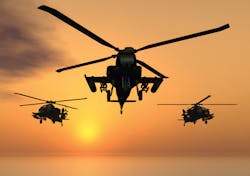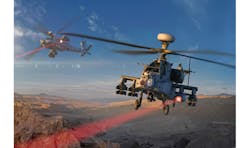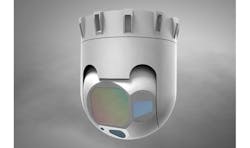High-energy lasers (HELs) are expected to be a key component in future weapons systems, and recent testing by Raytheon Co. and the U.S. Army have shown that these high-power optical weapons can be deployed as airborne systems. In late June, the first-ever firing of a HEL at a target from a rotary-wing aircraft was performed from a laser system carried by an Apache AH-64 (Fig. 1). The demonstration took place during flight testing at White Sands Missile Range, N.M.
The integrated HEL system was fired multiple times during the testing, at different altitudes and air speeds. The system performed as expected while tracking and directing energy with high resolution at a number of targets. During the experimental tests, the moving HEL system tracked and directed energy at a stationary target at a slant range (the line-of-sight distance between two points at different levels) of 1.4 km. Testing provided evidence of the viability of using such a weapon on the battlefield, and also provided data on the various effects of rotary-wing air flight on the propagation of a HEL for future design enhancements.
“Our goal is to pull the future forward,” said Art Morrish, vice president of Advanced Concept and Technologies for Raytheon Space and Airborne Systems. “This data collection shows we’re on the right track. By combining combat proven sensors like the MTS, with multiple laser technologies, we can bring this capability to the battlefield sooner rather than later.”
The test system included a variant of the Multi-Spectral Targeting System (MTS) system, a highly integrated sensor subsystem which features electro-optical/infrared (EO/IR), laser designation, and laser illumination functions in a single package. MTS sensors (Fig. 2) feature multiple fields of view, electronic zoom, and multimode video tracking. For the experimental flight, the MTS provided targeting information, situational awareness, and beam control.
The combat-ready MTS family of sensors has nearly four million operational flight hours. More than 3,000 of the sensor subsystems have been delivered to global customers. For example, MTS sensors provide long-range surveillance, target acquisition, tracking, range finding, and laser designation for the Griffin and Paveway missiles, as well as all tri-service and NATO laser-guided munitions.
About the Author
Jack Browne
Technical Contributor
Jack Browne, Technical Contributor, has worked in technical publishing for over 30 years. He managed the content and production of three technical journals while at the American Institute of Physics, including Medical Physics and the Journal of Vacuum Science & Technology. He has been a Publisher and Editor for Penton Media, started the firm’s Wireless Symposium & Exhibition trade show in 1993, and currently serves as Technical Contributor for that company's Microwaves & RF magazine. Browne, who holds a BS in Mathematics from City College of New York and BA degrees in English and Philosophy from Fordham University, is a member of the IEEE.



